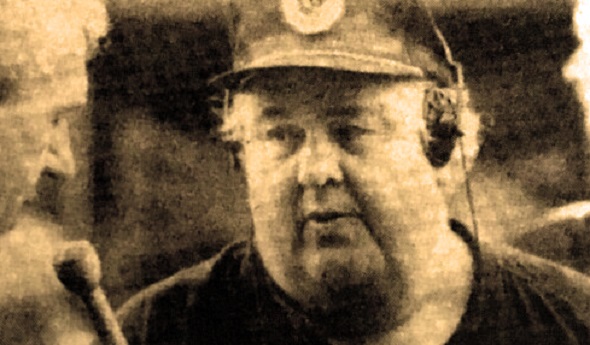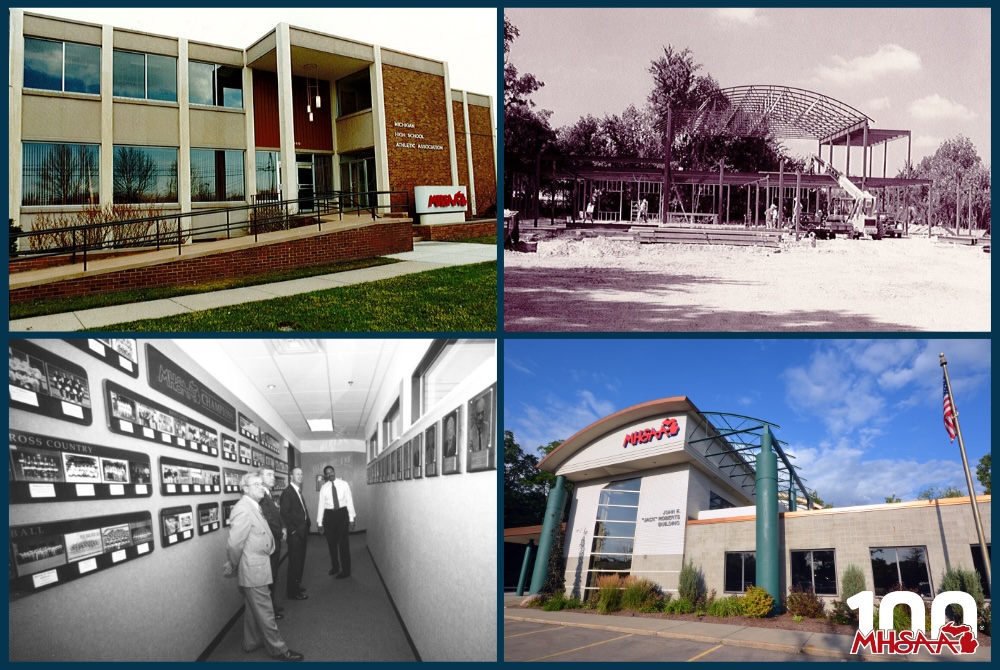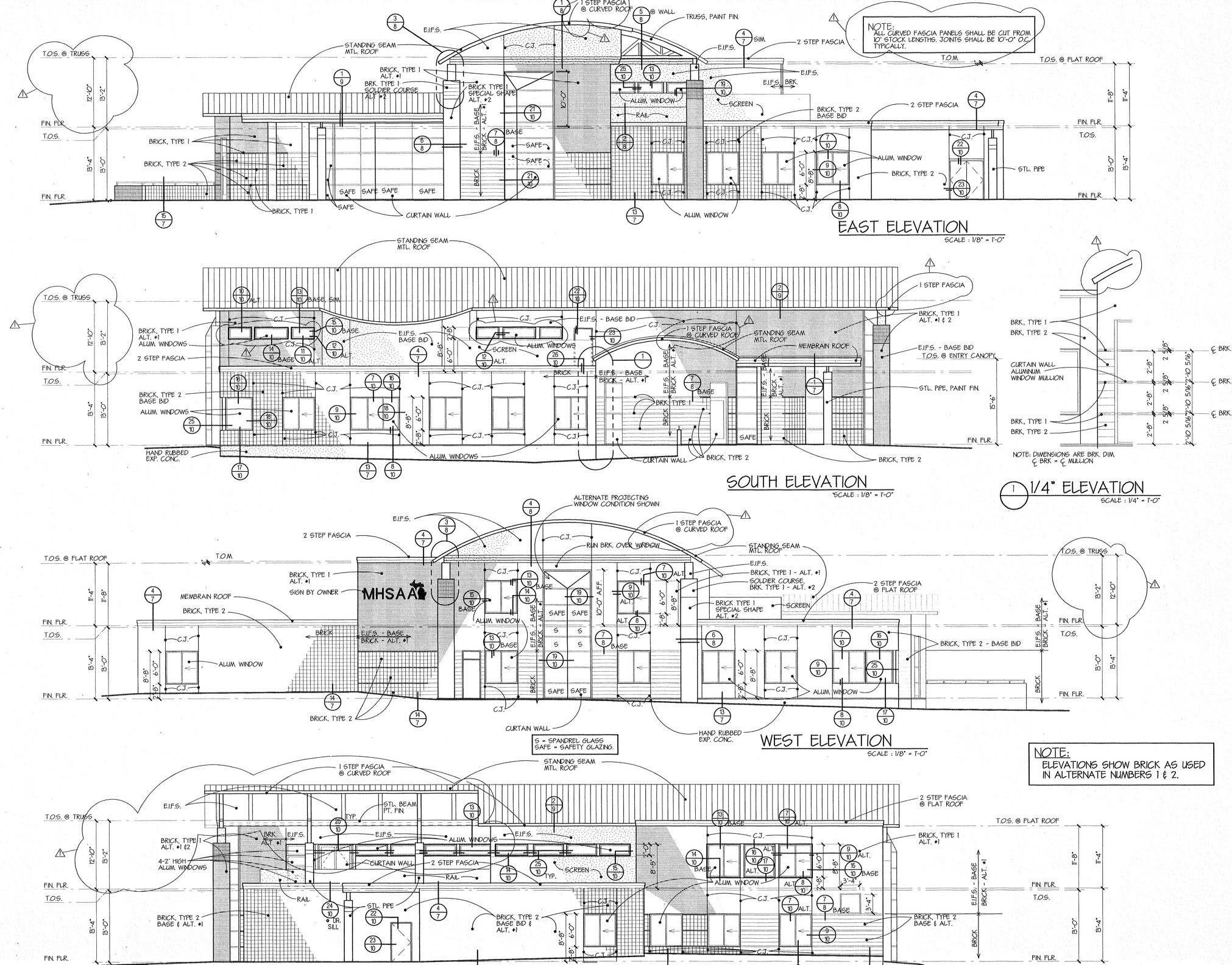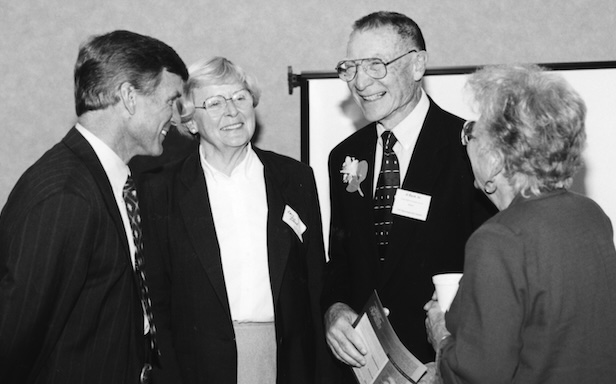
Radio Neighbors Begin 77th Years in HS Sports
September 6, 2018
By John Johnson
MHSAA Director of Broadcast Properties
Local radio coverage of high school sports can still be found in a lot of places these days – and for a couple of stations, they’re celebrating 77 years of service to school sports in 2018-19.
WTCM-AM in Traverse City and WJMS-AM in Ironwood are literally adjacent on your radio dial, but they’re 250 miles apart as the crow flies across Lake Michigan and through a lot of northeast Wisconsin. In 1941, they started their streak of broadcasting the preps into their local communities.
Mind you, there weren’t that many radio stations as you might think back then, when it was the only electronic medium. WJMS had signed on in November of 1931 and was only one of two stations in the Upper Peninsula at the time and one of 19 statewide, according to Federal Radio Commission records. One of the early issues the station faced was interference with its signal because of the density of iron mines in the area.
When WTCM went on the air early in 1941, there were still only 28 radio stations in our state; five were in the U.P., and WTCM was the only station in the Lower Peninsula north of Saginaw.
Les Biederman owned WTCM and was quickly persuaded by the locals to broadcast a Traverse City High School basketball game.
“So he got the equipment ready and got everything set up, they got permission and everything,” said Jack O’Malley, current program director at the station and a long-time play-by-play voice. “The night of the game, the superintendent says ‘You can’t do the game – the local newspaper is not real happy. They said if people listen to the game, they won’t buy the newspaper in the morning. So you can’t do the game.’
 “So the town had already been told – they were promoting it; and when 7 o’clock rolled around, they went on the air and they announced they were going to do the game tonight, but permission had been revoked, so we can’t do it. And then they left the microphones open at the gym so that everybody could hear the basketball dribbling, the crowd cheering, the horns honking.
“So the town had already been told – they were promoting it; and when 7 o’clock rolled around, they went on the air and they announced they were going to do the game tonight, but permission had been revoked, so we can’t do it. And then they left the microphones open at the gym so that everybody could hear the basketball dribbling, the crowd cheering, the horns honking.
“About 15 minutes later, the superintendent was at Les’ door, saying that the phones had gone crazy, you’ve got to do the game. They started with the game and we’ve been doing high school sports ever since.”
WTCM added football and other sports to the mix over time, which played well with Traverse City High School being the only public school in town. The station’s focus these days is football, alternating between Central and West High Schools.
“The whole idea is that we’re part of the community, and WTCM has always been a community radio station,” O’Malley said. “High school sports are all about community. People say, I remember when this kid played on that team and you watch all the kids as they grow up. It’s really a connection through the ages.”
The Biederman family continues to serve radio listeners in the north, with Ross Biederman as the president of what has become the Midwestern Broadcasting Company with four stations in the Traverse City market and two in the Alpena area. And yes, one of the Alpena stations is involved in covering high school sports.
The paper trail isn’t quite as tidy when documenting the history at WJMS. The station moved from its original frequency of 1420 to 1450 after being on the air for about six years, then to 630 in 1947 and its present 590 on the AM dial in 1968. Veteran observers of U.P. radio concluded that WJMS began broadcasting high school games in 1941, which was confirmed by several newspaper articles in the old Ironwood Times from that year.
The station’s signal footprint, which would eventually reach from Marquette to well west of Duluth, Minn., by day, was the early stomping grounds for some great broadcasters.
“I can remember when I was 9 or 10 years old, listening to Bob Olson and Joe Blake doing high school basketball and football in the early 60’s,” said Rod Halverson, who currently calls games for the station. “We had four local schools, Hurley (Wis.), Bessemer, Ironwood and Wakefield, which were all in the Michigan-Wisconsin Conference; and we covered those four schools. I remember listening and seeing those guys at the basketball games.”
Bob Olson, who died earlier this year, and Joe Blake went on from WJMS to purchase WMPL in Hancock in 1969. Olson would spend 35 years behind the microphone calling Michigan Tech ice hockey games and was legendary for his high-pitched tag going into commercial breaks: “This is Huskie Hockey from Houghton!” Blake would purchase WCKD in Ishpeming in 1971 (which later became WMQT-WZAM in Marquette) and run its operations until his death in 2004, calling Northern Michigan ice hockey and volleyball games. Both gentlemen received all kinds of accolades over the years.
But it was the style of an another announcer who followed Olson and Blake – Harry Rizze – who Halverson has worked hard to apply as he calls the games now.
“Harry Rizze was doing games when I started playing basketball,” Halverson said. “He made the games really personable. He would get to know the players by their first names – and he would use their first names on the air sometimes – that’s how close he got to the program. I thought it was a really nice touch. I’m doing some of that now, and I’m trying to emulate the two guys before me – Harry Rizze and Gary Aho.”
And in a place like the Iron Range of the Western U.P., there’s nothing like local radio covering local high school games.
“Some of the players I broadcast now, I played against their dads,” Halverson said. “You get to know everybody. Up here, we cover all of the schools the best we can. I feel bad for the areas that don’t have radio coverage.”
PHOTOS: (Top) Longtime WJMS broadcaster Harry Rizze conducts an interview. (Middle) Late WTCM owner Les Biederman.

Century of School Sports: MHSAA's Home Sweet Home
By
Rob Kaminski
MHSAA benchmarks editor
November 5, 2024
Visitors to 1661 Ramblewood Drive for the multitude of MHSAA committee meetings, in-services and other functions are sure to see the faces of Michigan’s renowned educational athletics leaders throughout the years on various recognition boards.
Absent from any of those displays is the late East Lansing resident Thomas Reck. Yet, Reck and the long-range vision of Jack Roberts were equally as vital in “restructuring” the MHSAA in the late 1990s; quite physically.
“I really wanted something along US-127 – visible from 127 – and there was a good deal of open land where the building sits now that looked to be about the right size,” recalled Roberts, who at the time was just finishing the first decade of what would be an iconic 32-year run as the executive director of the MHSAA.
There was one potential roadblock to Roberts’ dream location: There was no indication of any kind that the property was for sale; no billboard, no realty listing.
That’s because it wasn’t for sale – yet.
“I contacted a realtor, Martin Property Development, and I suggested one of their employees call upon Mr. Reck,” Roberts said. “He did that, and got a purchase price of $600,000. To me, the excitement really took place before the first shovel went into the ground.”
The deal was then approved by both parties, and development began in 1996, with Reck’s residence remaining in place atop the small hill south of the new road leading to the proposed site of the MHSAA building.
“When we bought the land, there was no road,” Roberts said. “One of the reasons it curves is that Mr. Reck was given a life lease, so we had to go around his house. It also had to navigate some protected wetland areas.”
As for the name of the road, that was the MHSAA’s choice, one which actually came quite easily. The city of East Lansing had some concerns with the new development, and expanding on an existing name for the road was the first show of good faith by the newest tenants. Keeping the name Ramblewood made sense as there was already a Ramblewood Drive at the exact intersection to the east of Coolidge Road.
“We didn’t want to come in and change a lot of things, or inconvenience the residents in that area,” Roberts said. “We kept development back from the road and kept as much nature intact as possible. Even the signs that are there now are off the road and relatively small.”
Roberts and staff needed no signs to find their way to the new digs just more than three miles north of the previous offices on Trowbridge Road.
 Led by Roberts and former assistant director Tom Minter, much of the moving occurred during Christmas break of 1996. Doors to the new building were opened in January 1997, roughly seven years after Roberts first began dreaming of a new home.
Led by Roberts and former assistant director Tom Minter, much of the moving occurred during Christmas break of 1996. Doors to the new building were opened in January 1997, roughly seven years after Roberts first began dreaming of a new home.
The building on Trowbridge was formerly a credit union, and its structure provided some unique problems.
“In the late 1980s, around ‘88 or ‘89, we bought our first major computer, an IBM mainframe, and put it upstairs in the old building,” Roberts said. “It was about five feet high and eight feet wide and had its own room. We had to drill through concrete to wire it. I began to realize that we were going to have a hard time keeping up with things in a building that was so difficult to modernize.”
John Johnson, the MHSAA’s first communications director and a pioneer in that position among state high school associations, also reflected on the early days.
“Anything which was data-driven was jobbed out for awhile,” Johnson said. “Football playoff rankings were delivered to us once a week from a third party. We were doing everything outside the building: school databases, officials databases, penalty databases. The only thing we had inside the walls was word processing. I had the first PC in 1987.”
And, he recalled, the beast of a mainframe that took up an entire room at the expense of personnel. “Yep, it took up the whole room,” Johnson confirmed. “I was in what was called the library, which had historical books, but also old T-shirts left over from previous years’ champions.”
That lack of storage was also motivation for Roberts to find new real estate, and addressing that shortcoming was paramount in the plans.
“We had no storage, and no efficient way to receive shipments like rules books, paper, and the basic supplies we needed to run our business,” Roberts said. “That’s also why we have the lift in its current location at the new building; shipping and receiving were really important to us, along with our drop ceiling which made it much easier to run wiring as needed.”
As sparkling and expansive as the new facilities were, perhaps the best feature of all was its cost. The structure only took up a portion of the land purchased by the association, per Roberts’ vision. That left four parcels on the property for sale by the MHSAA, and with the road and utilities in place, those sections became even more valuable and enticing.
The MHSAA’s expenditures totaled roughly $1 million for the purchase of the land, road construction and utility installations. The parcels then sold for approximately $300,000 apiece.
“In the end, we had our space free of charge, and had $200,000 for furnishings,” Roberts said. The lone cost would then be the actual construction of the building, financed through a bond. And, the MHSAA could choose their neighbors, which was also part of the grand plan.
“We were going to be particular about who moved in, and that they’d be further back; not right on the road,” Roberts said. “Above all, we wanted to be good neighbors to the residents in the area and choose businesses that would be good neighbors as well.”
The other four parcels are occupied by medical practices, and the area remains a somewhat sleepy and hidden subdivision to this day.
Interestingly, and unknown to most, the MHSAA nearly held on to the parcel closest to its front door as a rental venture. That prospect led to spirited but friendly debate among Representative Council members at the time, leading to a vote on the matter of whether to sell the land or construct another building and rent space in that structure.
“There was good-natured discussion on the topic with arguments both in favor of selling and for building and renting on that last parcel,” Roberts said. “I remember on the morning of the vote, I offered the Council this to think about: We were really good at rules, really good at interpretations and administration of school sports. None of us were landlords or experts in that field.”
By a 10-9 vote, the Association would sell the final plot. “We didn’t get greedy, and history showed it was the right decision, what with the housing market landscape years later,” Roberts said. “We’d already won the lottery in a sense. Why enter into an area in which we knew little about?”
The timing of this new gem couldn’t have been any better, as the MHSAA was hosting the Section 4 meeting of state high school associations in September 1997. It was the perfect opportunity to showcase the facility with an open house attended by those in town for the meeting as well as current and former MHSAA staff and dignitaries.
Met with the now-recognizable and unique high-arching “roof” – half copper and half green, open frame – visitors were impressed. “The architect was on vacation in Florida and saw a similar building with the copper roof. When she assured me that it wouldn’t turn green over time, I agreed to do it,” Roberts said. “The design is actually still trendy, so it’s held up over time.”
Indeed it has, as verified by builders and designers currently giving the MHSAA’s home its first facelift.
“When I told people how old the building was, they couldn’t believe it, because its design has held up so well,” said MHSAA Assistant Director Dan Hutcheson, who has worked closely with contractors on building renovations during the last several months.
Even prior to this expansion and cosmetic overhaul, the MHSAA and its technology, staff were looking to the future.
 “Ironically, we upgraded projectors and cameras to delve into Zoom and virtual meetings before we really even knew what they were or how valuable they could be,” Hutcheson said. “This was winter of 2020, and a couple months later, Covid hits and by luck we’re kind of prepared, at least communication-wise.”
“Ironically, we upgraded projectors and cameras to delve into Zoom and virtual meetings before we really even knew what they were or how valuable they could be,” Hutcheson said. “This was winter of 2020, and a couple months later, Covid hits and by luck we’re kind of prepared, at least communication-wise.”
Following the Covid-19 pandemic, once the MHSAA was back on solid footing, Executive Director Mark Uyl began to outline and identify areas for expansion and updating inside the building.
Roberts’ foresight in the initial storage and expansion areas have paid huge dividends, as plenty of space existed for new offices.
The first meeting with architects post-pandemic was in September 2022, with renovations beginning in September 2023. Now, two years later, the project is near completion.
New color schemes, video boards, LCD displays and touchscreens serve to keep the facility in stride with those to which the MHSAA’s constituents have become accustomed.
There was plenty of work behind the scenes, too, such as fixtures and plumbing which simply had exceeded their lifespan or needed to be brought up to current codes. The overall mission for the changes, as always, was to better serve the membership.
“We serve 750 member schools, with so many from those schools coming here for training, teaching and educational sessions,” Hutcheson said. “As our staff members visit schools around the state, we see video boards, electronic message boards. We needed to keep in step with the schools, and in doing so, better assist our ADs, coaches and officials with their work.”
For two people who didn’t know one another, Reck and Roberts brought countless people together since 1997 to help them do their work.
Previous "Century of School Sports" Spotlights
Oct. 29: MHSAA Summits Draw Thousands to Promote Sportsmanship - Read
Oct. 23: Cross Country Finals Among MHSAA's Longest Running - Read
Oct. 15: State's Storytellers Share Fall Memories - Read
Oct. 8: Guided by 4 S's of Educational Athletics - Read
Sept. 25: Michigan Sends 10 to National Hall of Fame - Read
Sept. 25: MHSAA Record Books Filled with 1000s of Achievements - Read
Sept. 18: Why Does the MHSAA Have These Rules? - Read
Sept. 10: Special Medals, Patches to Commemorate Special Year - Read
Sept. 4: Fall to Finish with 50th Football Championships - Read
Aug. 28: Let the Celebration Begin - Read
PHOTOS (Top) Clockwise from top left: The former MHSAA office on Trowbridge Road. (2) Work is underway on the new MHSAA building on Ramblewood Drive. (3) The MHSAA office on Ramblewood before recent updates that included a switch from green to gray on the exterior. (4) Now-retired assistant director Nate Hampton, far right, and others walk the upstairs hallway of the recently-built Ramblewood building. (Middle) Blueprints for the Ramblewood office exterior. (Below) Past Executive Director Al Bush (right) and his wife, Lois, were on hand for the 1997 open house hosted by then-Executive Director Jack Roberts (left) and staff. (MHSAA file photos.)

